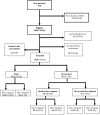Virological failure and HIV-1 drug resistance mutations among naive and antiretroviral pre-treated patients entering the ESTHER program of Calmette Hospital in Cambodia
- PMID: 25166019
- PMCID: PMC4148321
- DOI: 10.1371/journal.pone.0105736
Virological failure and HIV-1 drug resistance mutations among naive and antiretroviral pre-treated patients entering the ESTHER program of Calmette Hospital in Cambodia
Abstract
Introduction: In resource limited settings, patients entering an antiretroviral therapy (ART) program comprise ART naive and ART pre-treated patients who may show differential virological outcomes.
Methods: This retrospective study, conducted in 2010-2012 in the HIV clinic of Calmette Hospital located in Phnom Penh (Cambodia) assessed virological failure (VF) rates and patterns of drug resistance of naive and pre-treated patients. Naive and ART pre-treated patients were included when a Viral Load (VL) was performed during the first year of ART for naive subjects or at the first consultation for pre-treated individuals. Patients showing Virological failure (VF) (>1,000 copies/ml) underwent HIV DR genotyping testing. Interpretation of drug resistance mutations was done according to 2013 version 23 ANRS algorithms.
Results: On a total of 209 patients, 164 (78.4%) were naive and 45 (21.5%) were ART pre-treated. Their median initial CD4 counts were 74 cells/mm3 (IQR: 30-194) and 279 cells/mm3 (IQR: 103-455) (p<0.001), respectively. Twenty seven patients (12.9%) exhibited VF (95% CI: 8.6-18.2%), including 10 naive (10/164, 6.0%) and 17 pre-treated (17/45, 37.8%) patients (p<0.001). Among these viremic patients, twenty-two (81.4%) were sequenced in reverse transcriptase and protease coding regions. Overall, 19 (86.3%) harbored ≥1 drug resistance mutations (DRMs) whereas 3 (all belonging to pre-treated patients) harbored wild-types viruses. The most frequent DRMs were M184V (86.3%), K103N (45.5%) and thymidine analog mutations (TAMs) (40.9%). Two (13.3%) pre-treated patients harbored viruses that showed a multi-nucleos(t)ide resistance including Q151M, K65R, E33A/D, E44A/D mutations.
Conclusion: In Cambodia, VF rates were low for naive patients but the emergence of DRMs to NNRTI and 3TC occurred relatively quickly in this subgroup. In pre-treated patients, VF rates were much higher and TAMs were relatively common. HIV genotypic assays before ART initiation and for ART pre-treated patients infection should be considered as well.
Conflict of interest statement
Figures
References
-
- Gupta RK, Jordan MR, Sultan BJ, Hill A, Davis DH, et al. (2012) Global trends in antiretroviral resistance in treatment-naive individuals with HIV after rollout of antiretroviral treatment in resource-limited settings: a global collaborative study and meta-regression analysis. Lancet 380: 1250–1258 S0140-6736(12)61038-1 [pii];10.1016/S0140-6736(12)61038-1 [doi] - DOI - PMC - PubMed
-
- WHO (2009) Rapid advice: antiretroviral therapy for HIV infection in adults and adolescents. WHO. Available: http://www.who.int/hiv/pub/arv/advice/en/.
-
- WHO (2010) Antiretroviral therapy for HIV infection in children: towards universal access-recommendations for a public health approach, 2010 revision. - PubMed
-
- Westley BP, DeLong AK, Tray CS, Sophearin D, Dufort EM, et al. (2012) Prediction of treatment failure using 2010 World Health Organization Guidelines is associated with high misclassification rates and drug resistance among HIV-infected Cambodian children. Clin Infect Dis 55: 432–440 cis433 [pii];10.1093/cid/cis433 [doi] - DOI - PMC - PubMed
Publication types
MeSH terms
Substances
LinkOut - more resources
Full Text Sources
Other Literature Sources
Medical
Research Materials



